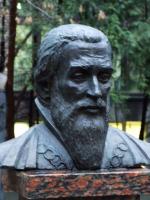Proceedings of M.Miechowski and S. Herberstein
on Tatars
Zharkikh M.I.
Heroes of our article are two geographers of the 1st half 16 century.
Pole Matthew Miechowski was born in the town Miechow near Krakow in 1457 year. He become famous as a scientist – a physician, astrologer, long-time chairman of Krakow University, author of historical work "Chronicle of Poland" and geographical work "Treatise on the two Sarmatia". This is a geographical work written on the basis of desk studies and was first published in 1517. Miechowski died in Krakow in 1523.
S. Herberstein's bust in Moscow, in a court of Foreign Languages Library.
Photo M.I.Zharkikh, 4 Dec 2008
German Sigismund Herberstein was born in a castle Vippah in Styria in 1486. He visited Russia twice – in 1517 as ambassador of Emperor Maximilian, and in 1526 as ambassador of Austrian Archduke Ferdinand. During his ambassadorial trips he collected extensive material on the history and geography of eastern Europe. He handled this material and in 1549 published the book "Notes on Muscovite Affairs". Herberstein died in 1566.
S.Herberstein read and used the "Treatise on the two Sarmatia". At the time of second trip Herberstein was already well acquainted with the Miechowski's treatise (for the period 1517 – 1526 treatise was published in different languages 4 times, and have editions in the next decade). Herberstein tried to check and precise information of "Treatise" directly in place. Herberstein was one of the first readers and critics of Miechowski's geographical work.
In this paper we try to trace the patterns of geographic information of Miechowski in the Herberstein's work, taking the example the notes on the Tatars.
Contents (full text in Ukrainian)
More information about the Tatars
Conclusions
1. Both of the works – "A Treatise on the two Sarmatia" M. Miechowski and "Notes on Muscovite Affairs" S. Herberstein – were caused by era of geographical discoveries. Since the late 15 th century. Europe began to discover the world around it with quite a practical purpose – to capture it and convert to their colony.
2. Both works on the whole disappointing conquistadors: it appears that the east European states have army, governments, money and trade. To seize them seems to be not very promising and protracting, especially at a time when overseas land fell to the feet of the invaders themselves, without any resistance (effort were required only to sail to these lands).
3. Miechowski's "Treatise" found in the person Herberstein attentive, interested and competent readers. Herberstein used this book as a source for his own work, bowworing that it seemed useful, while rejecting errors of predecessor or giving new information instead of them.
4. Plan and structure of "Treatise" does not affect the plan of Herberstein's book that emerged quite independently.
5. Overall Herberstein's book has become a new significant step – the next after "Treatise" – to acquaint European readers with the history and geography of eastern Europe.
6. Herberstein put into circulation new substantial material on the history of the Tatars, it is taken from the discussions in Moscow and reading Moscow chronicles. In this part of the labor he used aslo Polish chronicles, some cosmographical materials and some of ancient origin. The definition of these sources is the question of further research.
7. Using both sources of information on Tatars ethnography (and possibly other topics) one should remembered that both authors have introduced to this topic European idea of walking everyday life of nomads. Recorded in the book we discussed, specially devoted to Eastern Europe, as if these ideas were stamped "verified on the spot" and returned to 16-cent. Europe (And from there into the modern historiography) with the rank of first-hand observations. In fact, here we come in contact with the literary tradition of an unknown (but anyway very large) depth. The separation of real historical Tatars from the European literature image is the subject of further studies.
Started October 14, 2004
Completed July 25, 2009


 246.62 Kbytes
246.62 Kbytes